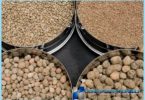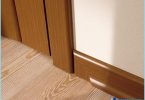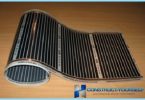The contents
- The composition of self-leveling compounds
- The types of self-leveling floors
- Necessary tools
- Work order
- Preparatory work
Although self-leveling floor is a highly effective technology, it has advantages and disadvantages that must be taken into account when choosing a method for forming a screed.
Advantages of self-leveling floor are:
- short maintenance break after pouring;
- water-resistant coating;
- the smoothness of the finished surface – this self-leveling floor can be laid directly on practically any of the final coating.
Thus, self-levelling screed for the floor convenient for those who are self building a house or renovating his house.
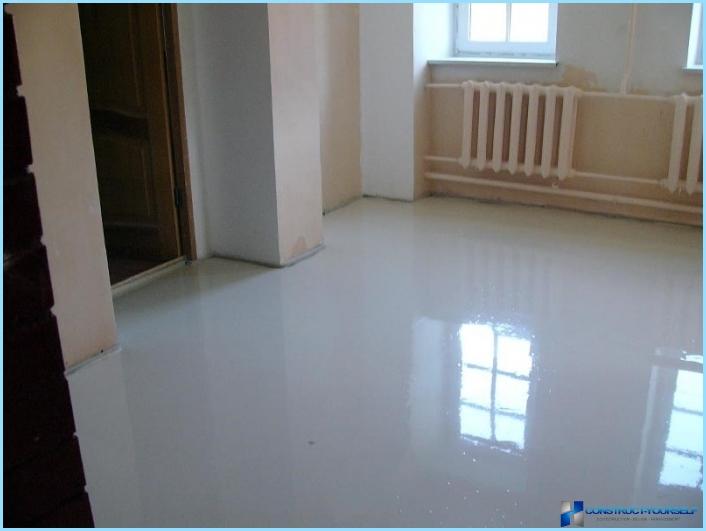
However, we must remember that self-leveling mix is more expensive than the components of conventional cement screed and fast drying floor requires high accuracy and speed while working. In addition, self-leveling floor is only good under the final flooring – laminate and other flooring and is not suitable for painting or the use of uncoated.
The composition of self-leveling compounds ↑
On base material mixtures for self-leveling floor are:
- cement;
- gypsum.
Cement mix is a versatile and suitable for any room. They dry quickly (within 5 hours) and have high strength. The thickness of the layer of the cement mixture may be from 2 mm to 5 cm.

A mixture of plaster are not suitable for rooms with high humidity. However, their advantage is high conductivity, so they are well suited for the installation of warm floor. The thickness of the layer of the gypsum mixture, up to 10 cm, so she’ll do well with big bumps.
As fillers are usually limestone or quartz sand.
In addition, the mix includes modifiers, plasticizers, substances to improve adhesion, water retention, and other substances, to ensure the spreadability, drying speed and other parameters.
The types of self-leveling floors ↑
Depending on the purpose of the mixture can be divided into:
- coarse (thick) the levelling mixes are used for initial alignment of the floor; when pouring from the container they spread out completely and require additional leveling;
- the finish (thin), levelling floor mixes – for a final floor leveling.
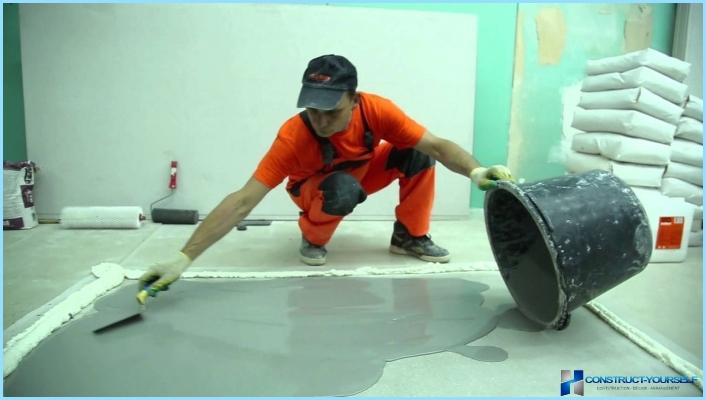
Rough levelling floor mixes should be used when significant irregularities, as they are much cheaper than thin. After pouring coarse dry mix is desired flatness of the screed provide a fill finish dry mix.
Necessary tools ↑
For pouring self-leveling floor will need:
- drill with mixing technology attachment – for mixing;
- rubber spiked roller with long needles, 2 mm more than the thickness of the layer for leveling the surface and remove bubbles;
- damping tape is placed around the perimeter of the upper floor;
- bubble level with a length of 50-100 cm – to determine the roughness of the original surface;
- putty – to prepare the base;
- screw the beacon to determine the required level of the solution when pouring;
- capacity for a mixture – not less than 25-30 years, as well as a bucket for rinsing instruments;
- krasnostup – walk on the casted floor.
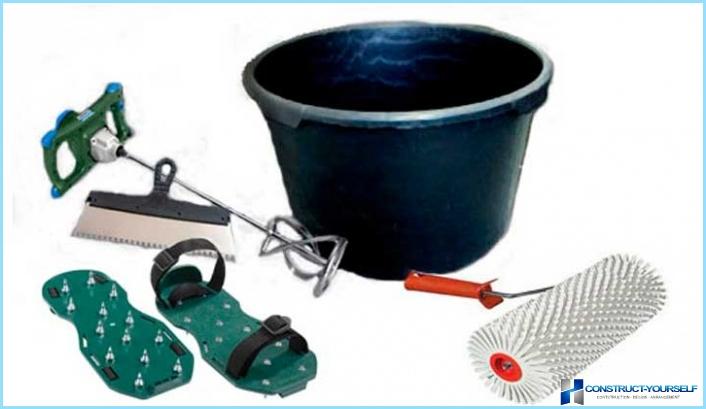
All tools should be prepared in advance and to be at hand, since the delay of the coupler will harden and smooth surface will not work.
You will also need to buy the very self-levelling compound, primer (if needed before pouring the ground floor) and possibly river sand – he needed to prepare semantischen and gipsopeschanoj floors; the need for it and the characteristics of the sand are indicated by the manufacturer.
Work order ↑
Pouring self-leveling floor takes place in 3 stages:
- Surface preparation for fill.
- Preparation of a mixture of.
- Fill
Preparatory work ↑
The definition of the characteristics of the floor ↑
First you need to determine the characteristics of the framework depends on whether it is possible to use a self-levelling floors or to use the traditional cement screed, but also to determine the desired self-leveling mixture.
These features include:
- strength base – lack of strong foundations will require additional treatment; at home, the strength can be determined using a glass cutter: if width of the scratch is greater than the width of the roller cutter, it is possible to produce a fill with no additional work.
- the moisture content of the surface is checked using plastic film left on the surface for a day: if the film is formed, the sweat, the surface of the basics must be primed before filling; however, if the film formed drop – pouring self-leveling floor can be made only after waterproofing the basics (or even to abandon this technology in favor of traditional ties);
- humidity – in humid rooms (kitchen, bathroom, etc.) you can only use the mix on a cement basis;
- the evenness of the Foundation – to determine the version of fill (single layer or double layer) and the required amount of the mixture; checking the bubble level.
Preparation for pouring ↑
Preparing the room to fill, you need to remove his furniture, garbage and sweep the dust. If dust appeared again – the Foundation needs to be primed. You also need to ground the basis in the case that it has a high moisture content.
If the concrete is cracked – they should be pre-patched.
Cook the mixture and pouring ↑
Pouring self-leveling floor is performed in the period from 4 to 24 hours after the primer.
For self-leveling floor mix consumption per m2 for 1 mm (dry matter) specified by the manufacturer. To determine the total consumption, it is necessary to multiply this value by the product of the area of premises in square metres to the thickness of the layer in millimeters.
To calculate self-leveling floor, you can use the calculator on the website.
Preparation of a mixture of ↑
The amount of mixture is determined based on the average of irregularities subject to correction factors. Be aware that for gipsopeschanoj and cementoplasty flooring sand may need to be purchased separately. Requirements for sand specified by the manufacturer. For rough levelling mixes commonly used sand fraction 0.4–0.8 mm for thin – sand fraction of 0,25–0,35 mm. the Sand must be river – because it is composed of rounded granules, which spreads good polymer. Quarry sand for mixing is not suitable.
While preparing it is necessary to strictly follow the manufacturer’s instructions listed on the package. Also the packaging indicates temperature range for fill (usually from 15º C to 30º C). If work is done at lower temperatures – the floor is not acquire the necessary strength and will quickly crack. If the floor is poured at a higher temperature than indicated by the manufacturer, the mixture dries too quickly, failing to spread and the floor get rough.
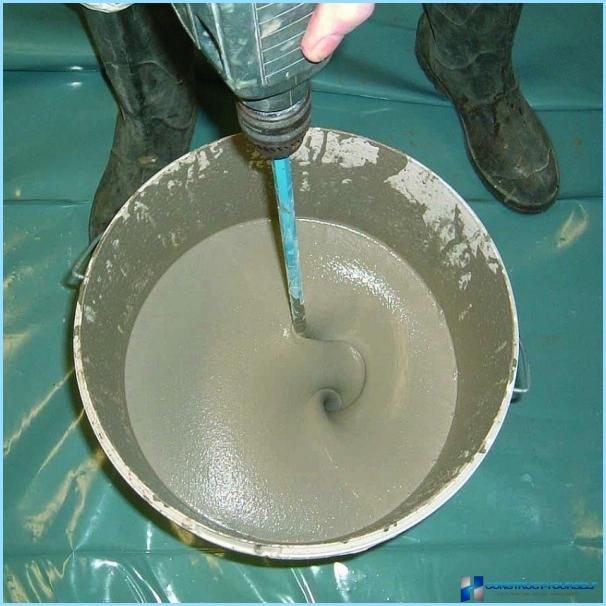
Knead the mixture in portions of half of the bag or pouch. First, in a container filled with water, then poured the dry mixture. The solution was stirred with a drill mounted mixing technology, operating at low speed (300 rpm). The duration of mixing for 3-4 minutes (to tighten the mixing impossible). After mixing the solution should «Mature» within 3-4 minutes,
Fill ↑
To determine the level fill in the highest level of the surface of the set screw lighthouse. Other screw beacons arranged around the perimeter of the room. Produce fill under the level of the lighthouse. After pouring and drying of the floor-beacons removed from the screed, and the resulting deepening pour the mixture.
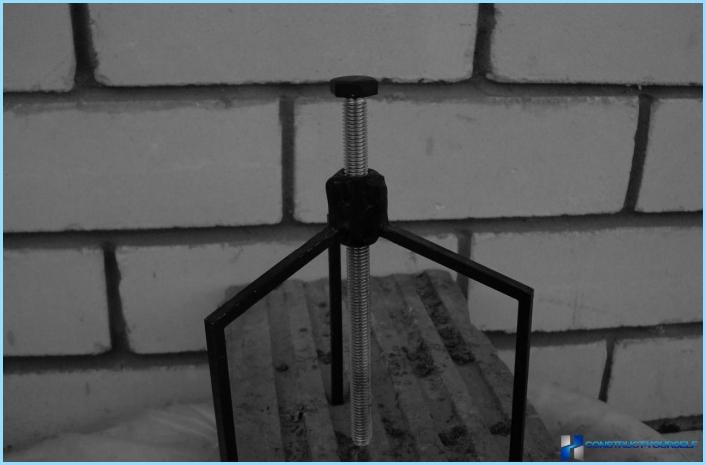
The mixture is poured on the base in small portions and leveled. Fill the next batch is from the end of the previous.
Since the floor hardens quickly, it is desirable to make the fill not one, but with an assistant – otherwise there is the risk of not getting the smooth floor. The task of the assistant is to prepare the next portion of the solution until the current poured on the floor. «Life time» solution depending on the form of a mixture is from 15 to 40 minutes and during that time need to completely fill the entire surface, and upon completion of the fill surface should be still frozen.
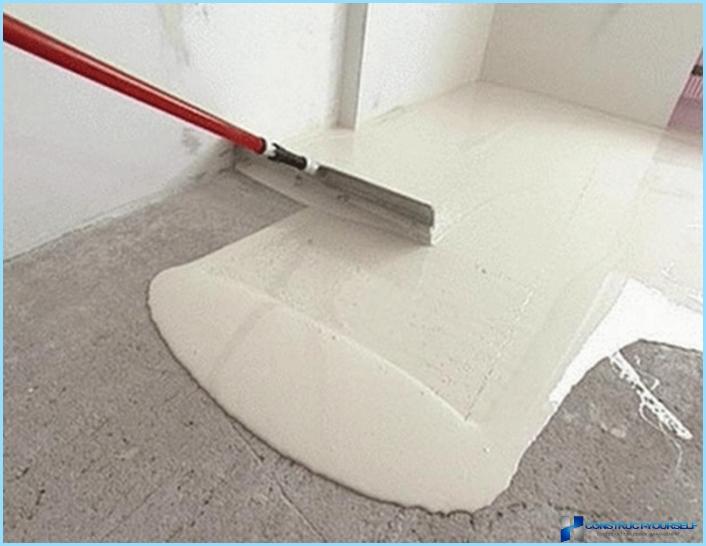
After pouring, the surface is leveled. It is convenient to use a needle roller, simultaneously removing the formed in the layer of bubbles.
If you need to apply an extra layer, this must be done within 10 minutes after application of the previous layer, because the larger the break, the previous layer has time to dry.
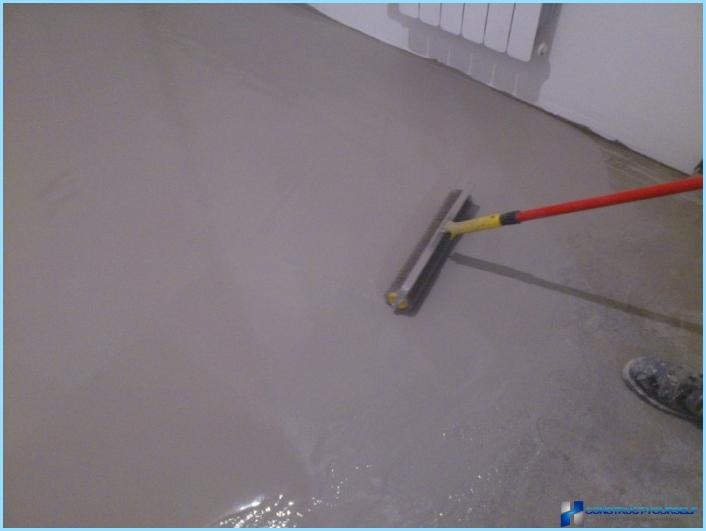
The whole process of marking and casting the floor you can see in the video
How many dry self-levelling floor? It usually takes 3 to 14 days depending on the kind of mixture, temperature and humidity.
Conclusion ↑
Thus, self-leveling floors is an excellent choice when the repair of an apartment or building that must be performed in a short time. It can fill and a layman, one only needs strict adherence to instructions, punctuality and good organization of work.

